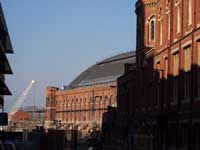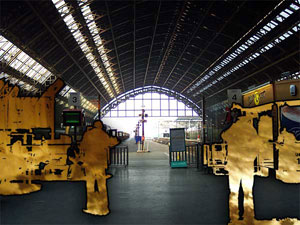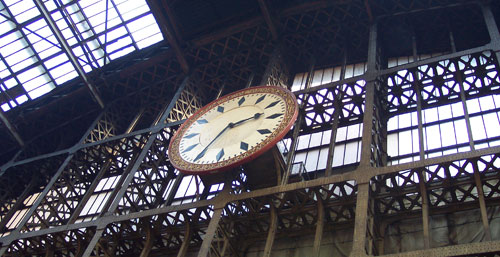


The Derelict Sensation: Way Station
Hilary Powell
 |
 |
 |
Railway terminuses have historically acted as catalysts of urban revitalisation,
capital and enterprise. St Pancras is due to become one of the largest passenger
interchanges in Europe and the surrounding area is undergoing major structural
and cosmetic changes as it prepares to become the ‘meet and greet’
location for the capital.
As the bulldozers and cranes move in, the twin clocks of Kings Cross attempt
to keep time over this rapidly changing area. It is in this period of transformation
that we took our place in the site where this fusion of past, present and future
is most apparent - The Midland Grand Hotel.
The station and
hotel were built as places of accelerated exchange and transit and the aim of
“The Derelict Sensation” does not differ so greatly in it’s
aims.
The advance of rail brought with it a changing force of perception of the environment
and scale. This site responsive event also aims at a change in perception of
the site.
Victorian supporters described the hotel as a “gothic phantasmagoria”
–“ its value to the London skyline is inestimable…high as
a cliff crowned with a pinnacled castle in a Grimm’s fairy story…drawing
up with complete confidence into the sky assaulting rage of turrets”.
(David Piper)
The romanticism surrounding the site remains as it has indeed become a “sleeping
beauty” awaiting a new awakening in it’s complicated life cycle.
Such romance now generates an income as the former hotel is in continual use
as backdrop to events and film shoots. However, “The Derelict Sensation”
aimed at moving beyond hotel as backdrop and emphasised the critical relationship
and interaction between the event and the site - opening up the monumental to
an alternative program or reading by the transgression of formal and cultural
expectations.
Architecture today cannot claim permanent meaning as it is always open to the
conversion of purpose and design. The long- term program for The Midland Grand
as luxury hotel with loft conversions may signal a return to its original function
devoid of the elements that caused its downfall. Technology has advanced, trains
no longer spew soot and thunder and the hotel has coped with the insidious fumes
of traffic for half a century. It was built to last and is determined to do
just that.
Stations have
always been places of theatricality and mobility. In “Remembrance of things
past” Proust refers to them as “Tragic places, for in them the miracle
is accomplished whereby scenes which hitherto have no existence save in our
minds are about to become the scenes amongst which we are living.” They
are places where things happen, where real life dramas occur and around which
fictional dramas pivot.
This quotation is apt in reference to “The Derelict Sensation” drawing
together myriad imaginations and interpretations of the site, linking fragments
of the past and present and potential futures and composing them in new constellations.
Terminals are
not only the end of the line –rather far reaching distribution points.
This actual two - day show in this terminus hotel follows the classic pattern
of arrivals and departures facilitating a temporary rendezvous with the space
and the artists and visitors. It is a relay, a trace – an in-between meeting
place prompting a moment of shock or turning point in expectations highlighting
value in the transitory.
As if touched by a passing strangers glance from a train in motion.
back
 |
photographs by Gillian McIver